Unpretentious tasty Carmenere grape variety
Carmenere is a technical dark grape native to the French region of Bordeaux. His second home was the sunny republic of Chile with its unique climate and rocky soil. The culture got its name from fr. carmin - one of the brightest shades of red that stains the leaves of the vine before leaf fall. We will talk about the features of agricultural technology and the use of the variety in winemaking in this article.
The content of the article
Description and characteristics of the Carmenere grape variety
Carmenere ripens late and requires a lot of sun and heat to reach full ripeness. When cultivated in favorable conditions, the plant provides raw materials for the production of wines with a rich, deep color and pleasant plum bouquet. In this it resembles Merlot and light cedar green tones of Cabernet Sauvignon.
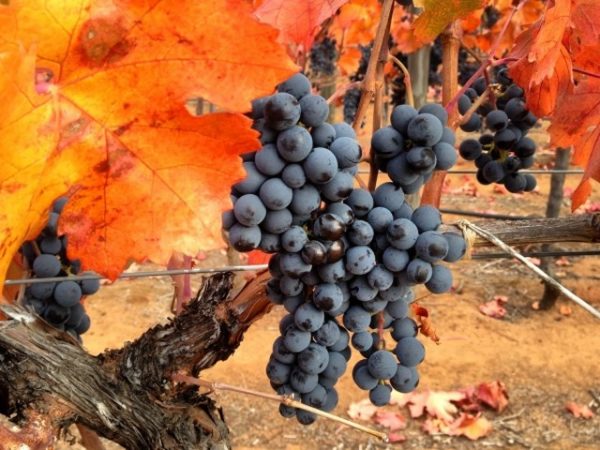
Origin story
The Carmenere grape variety is considered the progenitor of the Bordeaux grapes Cabernet Sauvignon and Merlot.... Both varieties were not popular in the region until the middle of the 18th century. Most of the wines were made from Carmenere and Cabernet Franc.
This situation persisted until the 60s. XIX century, when the phylloxera epidemic swept across Europe. Aphids were brought in from North America and quickly spread through the vineyards. Carmenere was the most susceptible to infection, and even grafting on the roots of American varieties with innate immunity did not improve the situation.
Cabernet and Merlot survived the vaccination without loss. It was because of poor grafting that most of the Carmenere vineyards perished, and growers abandoned its revival, preferring more tenacious crops.
Before the phylloxera situation, winegrowers from Chile managed to transport vines from Bordeaux and plant them at home. Most of the vines mistaken for Merlot turned out to be Carmenere. Initially, they were confused because of their external similarity, but this misunderstanding saved Carmenere from disappearing.
In 1994, the French ampelograph Jean-Michel Boursicot carried out a DNA analysis and found out that Chilean vineyards were planted by Carmenere. It is now Chile's flagship variety.
Due to the growing popularity of the Chilean Carmenera, vines began to be planted in other countries. The variety was included in the list of allowed for Italian categories DOC Friuli Latisana. Plantings in Italy are insignificant, but winemakers are interested in grapes.
Carmenere was discovered in the Matakana vineyards in New Zealand. Here he was mistaken for a Cabernet Franc clone. The vines were brought from Italy incognito, and the grapes gained even more popularity in the New World after the "exposure".
Description of the plant
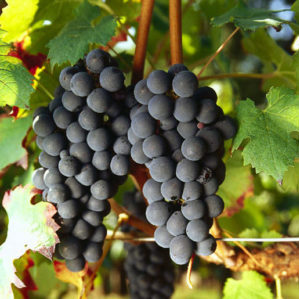
In Chile, Carmenere showed his best side. Grape growers are inclined to believe that the favorable climate and long summer contributed to this. Compared to Merlot, grapes have larger berries and a dense leaf structure. Harvesting is carried out only upon reaching full ripeness, otherwise it will disappoint with an immature taste.
Carmenere is a medium-ripening variety. The berries ripen 115-130 days after flowering. The bushes are characterized by high vigor and reach 2 m in height. Shoot formation is high.
The dark brown vine ripens 2/3 of its length, forms a voluminous hedge as shoots and foliage grow. The leaf blade is dense, three- or five-lobed, slightly dissected, covered with an edge on the back side, painted in bright green color. The flowers are bisexual, do not need additional pollination.
Clusters of medium or small size, drop-shaped or cylindro-conical, winged. Average weight - 800 g, maximum - 2 kg. The average bunch length is 30 cm.
Berries are medium-sized, rounded, up to 4 cm long, weighing 10-11 g. The skin is dense, dark blue or dark purple in color. The pulp is juicy, fleshy, herbaceous taste.
The calorie content of grapes is 67 kcal per 100 g of berries. The acidity is 6-8 g / l, the sugar content is high - 23%. The characteristics are preserved regardless of the cultivation area, the frequency of watering and feeding. Under favorable conditions, chocolate notes appear in the taste of the grapes.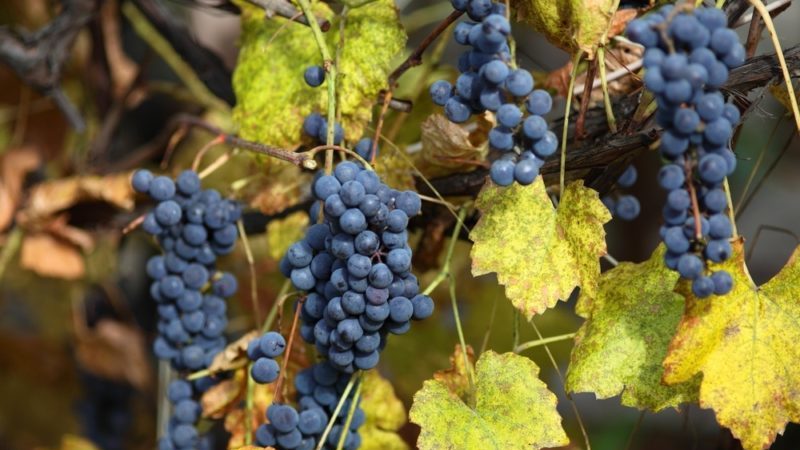
The fruitfulness of the eyes at the base of the shoot is low. Long pruning of fruit shoots is recommended. Grapes tend to shedding ovaries, so it is undesirable to plant it on soils with an excess of organic matter and in areas with a cool climate. In Russia, the climate of the Kuban and Crimea is suitable for the variety.
Compared to other varieties, Carmenere is resistant to mildew and powdery mildew, but is susceptible to gray rot.
The variety is relatively drought tolerant, characterized by low frost and cold wind resistance. When cultivating crops in areas where the mercury column drops below -20 ° C in winter, cover with dense materials is required.
The yield of the variety is average - 17-20 kg of berries are harvested from one bush. To increase productivity, regular pruning is carried out and mineral supplements are added during the growing season.
Advantages and disadvantages
The advantages of the variety:
- suitable for the production of rich red wine;
- ready-made drinks do not require aging;
- high taste;
- unpretentious care;
- resistance to mildew and oidium;
- the ability to adapt to any type of soil.
Disadvantages:
- low resistance to frost, cold winds and high humidity;
- tendency to peas;
- susceptibility to gray rot;
- high calorie and sugar content do not allow making table wines from raw materials;
- average yield.
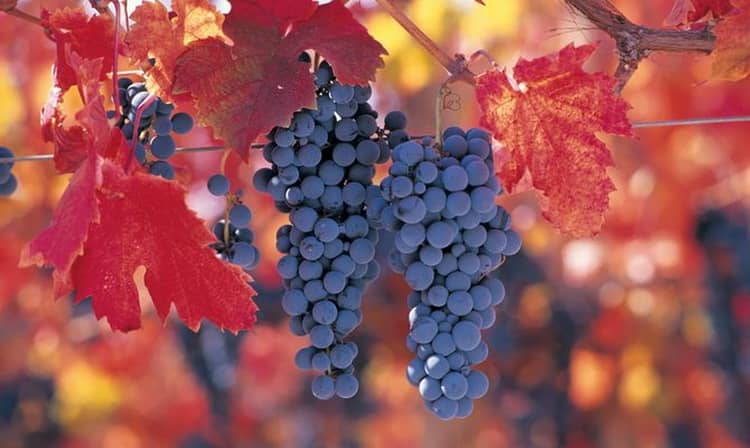
Similar varieties
Previously, ampelographs believed that Merlot and Carmenere were related, but DNA research showed that the varieties are distantly related.
Closest to the variety Cabernet Franc and Cabernet Sauvignon (Vidur). Carmenere is an independent, unique variety that has retained its identity, not much like other red grape varieties.
Wine from the Carmenere variety
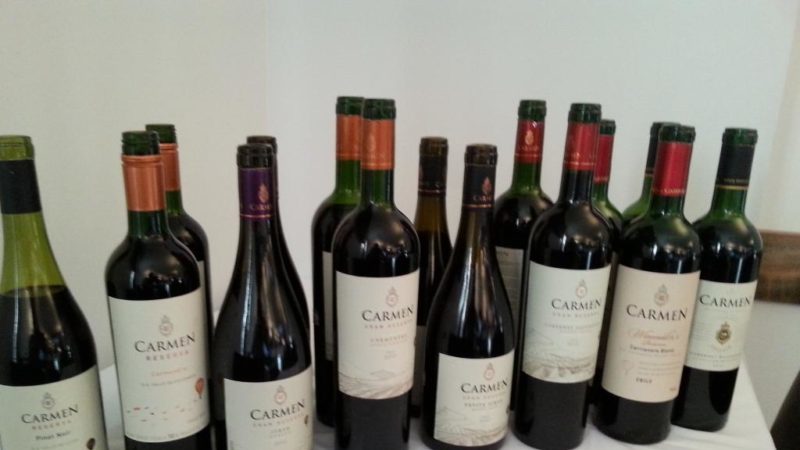
The most prestigious and iconic Chilean wines: Purple Angel by Montes, Kai by Vina Errazuriz, Carmin de Peumo by Concha y Toro.
Wines from the Carmenere variety are tannic, with a slight bitterness. They contain notes of spices, plums, prunes, figs and green pepper. As a rule, wines are drunk young, but the best examples are aged for several years.
These drinks are not served as an aperitif. The best gastronomic accompaniment for them is meat dishes (game, red meat), pasta with thick tomato sauce, aged cheeses.
Young wines with a herbaceous flavor are served with barbecues, mature ones - with roast duck, grilled beef or lamb, venison.
The wine makes an ideal pair with garlic, onions, mushrooms, dried and fresh tomatoes, bell peppers, eggplants, rosemary, basil, oregano, fresh herbs.
Reference. Carmenere include Saint-Estephe, Margaux, Bordeaux, Graves, Creman de Bordeaux, Medoc, Haute Medoc, Saint-Emilion Grand Cru, Saint-Julien in the appellations.
The main characteristics of wines based on the Carmenere variety:
- rich, with a predominant bouquet of plums and red berries, smoked meats, spices and smoke;
- full-bodied, structured, tannin, velvety in structure;
- dark purple, reddish purple.
Characteristic aromas:
- fruit: blueberries, raspberries, blueberries, plums, black currants, cherries;
- spices: black and white pepper, anise, cinnamon, vanilla, licorice;
- mineral: tobacco, wet earth, smoked meats, leather, coffee;
- vegetables: herbs, green bell peppers, olives, lavender.
Montes Alpha Carmenere 2008 was named Wine of the Month in December 2010 by WineAdvocate and received 91 out of 100 points from Robert Parker.
It is interesting:
What French and Kuban grape varieties are used to make cognac
Planting seedlings
The variety is recommended for planting and cultivation outdoors only in the southern regions. Carmenere is extremely susceptible to frost, drafts, high humidity.
When choosing a landing site, the light level is taken into account. Ideally - a sunny area, located on a hill, with low groundwater, protected from gusty winds. The culture adapts to any type of soil, in Chile it grows even in rocky areas.
Council. It is recommended to plant the grapes in the middle of the garden, along a wall or hedge to keep out the wind.
Saplings are planted in spring or fall. The second option is more preferable for inexperienced growers, since the survival rate of young seedlings is much higher.
The site is pre-plowed and pits 80 × 80 cm are formed.Crushed stone or broken brick is placed on the bottom, a layer of earth is poured, a seedling is planted, the roots are carefully straightened. The remaining soil is poured on top to the level of the root collar, compacted and watered abundantly.
To ensure underground watering when planting, a pipe is dug into the hole. In order to further tie the vines in the center, a wooden support is driven in.
Subtleties of further care
Competent, regular care of grapes ensures quick survival of seedlings and their correct development:
- The bushes are watered once a month with warm, settled water. Sprinkler irrigation is used in dry periods.
- Mainly mineral fertilizers are used as top dressing. An excessive amount of organic matter leads to overgrowth of bushes and thickening of plantings. During the flowering period, the bushes are fed with a mixture of 100 g of urea, 60 g of superphosphate, 30 g of potassium sulfate per 10 liters of water.
- Weeding the beds and loosening the soil is carried out regularly. Mulching with sawdust, peat or straw inhibits the growth of weeds and retains moisture in the soil.
- In regions with a cold climate, the vineyard is additionally covered for the winter with tarpaulin, agrofibre, thick film and spruce branches.
- Pruning is done twice a year, in spring and autumn. After harvesting, remove old, damaged branches, tops, dry shoots. At the beginning of March, sanitary pruning is carried out: the length of each fruitful shoot is reduced to 6-8 eyes.
Possible problems and diseases
Carmenera vines are abundantly overgrown with foliage, covering the bunches. Without pruning, the berries do not ripen, and the finished wine becomes bitter. The variety is prone to kulura - the fall of ovaries and young berries under the influence of cold, wind and rain with a lack of chemicals in the soil.
If a flower ovary is held on a bunch, but a small seedless berry is obtained from it, this is a pea. To avoid such troubles, they observe the rules of planting and agricultural technology, feed the bushes with mineral fertilizers.
Carmenere is resistant to most fungal infections, but is susceptible to gray mold. The disease develops against the background of high humidity and thickening of the bushes. Preventive treatment reduces the risk of infection. For this use fungicides "Horus", "Thanos", "Topaz" and "Ridomil", Bordeaux liquid, colloidal sulfur.
In case of infection, a sulfur solution is used - 100 g per 10 liters of water. The bushes are processed in the evening or in cloudy weather three times with an interval of 10 days.
To protect the grapes from the attacks of birds and wasps, a mesh bag is pulled over each bunch.
For the destruction of insects, including phylloxera, insecticides "Zolon", "Talstar", "Fury", "Angio 247" and biological products "Fitoverm", "Aktofit", "Lepidotsid", "Bitoxibacillin", Borey Neo "are used.
Harvesting and storage
Harvesting is carried out in August - early October.Ripe berries take on a deep purple hue. The bunches are trimmed with a sharp tool in dry weather and immediately sent for processing. Technical varieties of grapes are not stored and are used primarily for making wine.
Conclusion
Carmenere is an old French technical red grape that has received a "second life" in Chile. A rich tannin wine with tones of black currant, figs, prunes, smoke, smoked meats, plums, spices, and tobacco is prepared from dark blue berries. The young wine has a particularly pleasant herbal taste. The drink is combined with red meat and poultry cooked over charcoal, pasta, tomatoes, eggplants, peppers and a variety of herbs.
Carmenere adapts to any type of soil, but shows the best results when cultivated on rocky soils in regions with a warm climate. The culture needs moderate watering, mineral fertilizing, spring and autumn pruning and prevention of gray rot.